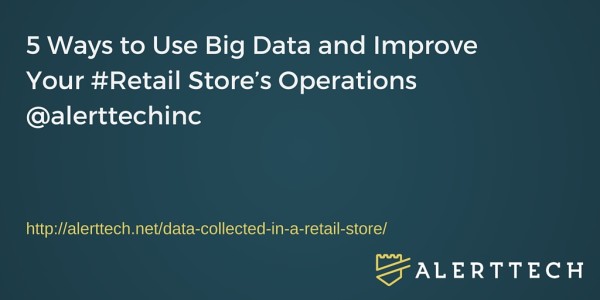How much data does your store collect every day? More importantly, how is that data used to help your store improve its sales, systems and services?
For many retailers, the answers to these questions are unclear. Does that sound like you?
The Internet of Things (IoT) is one of the hottest buzzwords in retail right now. In its simplest definition, it is the connection of one device to another. Usually, data (commonly referred to as “big data” because of how much information is gathered) is collected alongside this connection to improve retail store decision-making.
[Tweet “How are you using #bigdata to improve your retail store’s decision-making? @alerttechinc”]
The question many retailers are now asking is, how useful is the data collected in a retail store and what type of data should you be gathering?
How to Know What Type of Data You Need to Collect?
Before you get started, consider this: Why are you collecting data? What applications will you use this data for?
The first step is to decide on the problem you’re trying to solve. Common problems retailers face are:
- Long queue times
- Low conversions between foot traffic and sales
- Poor customer experience ratings
Related Post: How Long Queues Hurt Your Bottom Line More than Wait Times
Knowing the biggest problem in your retail store will help you distinguish the best way to tackle it using data.
Common Applications for Data Collection in a Retail Store
Still confused? You’re not alone. Big data is overwhelming when you’re not sure how to use it to your advantage.
Here are five of the most common applications retailers use for the data they collect.
1. Faster customer assistance
Perhaps one of the best ways to use technology is to provide faster customer service.
Wearable devices, overhead alerts, and two-way radios are all used to notify an associate when a customer needs assistance. These are ideal for any locked cabinet in your store or counter top that’s not regularly staffed.
[xyz-ihs snippet=”TOFU2-Retail-Technology-button”]
2. Reducing wait times
You can also use a smartphone or tablet to notify your associates when lines are disproportionate.
Smartphones and tablets use cameras so associates can see where there are long vs. short lines in your store. The less wait time your customers have to endure, the better their experience is with your store.
3. Text alerts
Queuing up is frustrating for most customers. Don’t force your potential buyers to stand in line. Use text alerts to notify your customers when a fitting room is open. The customer can reserve their spot in line and then continue shopping while waiting for the alert that their fitting room is ready.
4. Deal alerts
You can also use iBeacon technology to send alerts to your customers about special deals. This is especially helpful in boosting your sales and keeping your customers happy.
5. End-of-day analysis
Keep close tabs on your store by analyzing how you’re keeping up week after week. Look at conversion rates between foot traffic and buyers. Check out how many trips people made to the fitting rooms versus sales. There are so many types of end-of-day analysis you can do; the opportunities are endless.
[Tweet “Better customer service. Lower queue times. Stronger analysis. Big data is serving retailers well.”]
Bringing Your Data Together
The number of options you have for collecting and utilizing data is limitless. Data gives your store tremendous potential – you just have to start collecting it to see what it can do.
If you’re interested in updating your store’s data collection and connectivity, let’s talk. Contact an AlertTech representative to learn more about the solutions we have available and how they work.
[xyz-ihs snippet=”BOFU-Demo-CTA”]

